|
|
 It’s 1460. Katherine is a young nun, caught outside her English priory by a group of rampaging knights during the Wars of the Roses. Her life is saved by a slightly older monk, Thomas, but her reputation isn’t. Not only has she spoken to a man, but her closest friend has died under suspicious circumstances, and Katherine finds herself expelled from the priory. Under related circumstances, so does Thomas, and these two young people find themselves with nothing and nowhere to go in the middle of a bloody civil war, fleeing from a knight whose mission is to kill them. It’s 1460. Katherine is a young nun, caught outside her English priory by a group of rampaging knights during the Wars of the Roses. Her life is saved by a slightly older monk, Thomas, but her reputation isn’t. Not only has she spoken to a man, but her closest friend has died under suspicious circumstances, and Katherine finds herself expelled from the priory. Under related circumstances, so does Thomas, and these two young people find themselves with nothing and nowhere to go in the middle of a bloody civil war, fleeing from a knight whose mission is to kill them.
We’ve reached a bit of a saturation point with the Wars of the Roses, or at least I have. There are so very many books floating around about the Woodvilles, Richard III, Edward IV, the Princes in the Tower that it’s actually overwhelming, and no longer all that interesting in fiction. These royals have been considered from virtually every angle and it can seem like there isn’t anywhere new for fiction writers to go. Clements goes completely against that trend and focuses his novel on two ordinary people instead, who are simply caught up in what is wreaked by those who rule. In doing so, he creates something that is much more innovative and, ultimately, retains its interest in an over-saturated market.
In altering his focus, Clements allows us to take a completely different perspective on the war. Thomas and Katherine don’t really care who wins the war. They don’t even know what’s going on sometimes, though they do know the man who’s caused all of their troubles. They do their fair share of fighting and they even meet some of those figures about whom so many authors write. But this is a more personal struggle, viewed from a different level. They’re loyal to minor lords and it’s a member of the minor nobility who plagues them throughout the book. Everything else is more or less incidental, even though they travel across the Channel and back and feature in a few of the major battles fought during the war.
Both characters are sympathetic; I especially liked Katherine, but I wanted both of them to survive and thrive as best they could. Their personal struggles can easily strike a chord with readers; both have to find their way in a world outside the priory. They had assumed they would be there for their entire lives, but instead find themselves not only in a war but challenged with moral questions they never expected to encounter. The responsibility for killing people, the exposure to an outside world of sin, the fight for revenge; it’s very human.
Kingmaker: Winter Pilgrims took me a while to read because it’s fairly long, but I enjoyed it, getting wrapped up in their struggles and experiencing a little more what the other side of the Wars of the Roses would have been like. Recommended.
All external links are affiliate links. I received this book for free for review consideration.
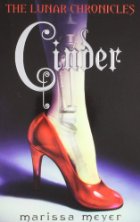 I had a high and lofty goal of writing about everything I read this year, even if only a sentence, at the beginning of the year. I’ve failed at that, but here are a few thoughts on books I have read and think are worth talking about this year so far. I had a high and lofty goal of writing about everything I read this year, even if only a sentence, at the beginning of the year. I’ve failed at that, but here are a few thoughts on books I have read and think are worth talking about this year so far.
Cinder, Scarlet, and Cress by Marissa Meyer
I loved these books. I went on a work trip to London and had to stay overnight back in February and I managed to read Cinder and Scarlet back-to-back on the evening (in between a trip to Forbidden Planet and a curry for dinner). I didn’t sleep much, needless to say, but I loved them. I got completely and totally absorbed in Cinder’s world. By a small stretch of time I managed to wait to read Cress - about a month – but my resistance wore down absurdly quickly and I devoured that one, too, although so far I think Cinder is my favorite. And now I have to wait all the way until 2015 for Winter, which seems pretty unendurable whenever I think about it!
It’s difficult to pin down why I loved them so very much. I really liked the way they reflected fairy tales, how they’re burdened by expectations and each girl has to make her own way, and because each book has a great romance going on (although I think Cress’s is probably the weakest) without being just about that romance. There is so much packed into each book, so much emotion and story. I even like how they reflect a wider scope of the world within fantasy and each girl comes from a different place and different walk of life. I so hope Winter is just as good as the first three books in this series.
 Germania, Simon Winder Germania, Simon Winder
I didn’t really love Germania, but I appreciated it a lot, and it reminded me of why Germany is so interesting. Winder basically goes off on a long, rambling, nostalgic and affectionate rant about Germany and takes his readers along for the ride. So while it isn’t an organized history of much of anything, it has a whole lot of charm. Just the subject of Germany is complicated now, still, in the shadow of both World Wars. They fundamentally changed the way that Germany was perceived by the rest of the world, especially Europe, and Germany’s reputation hasn’t recovered in the way. Anecdotally, I’ve never met anyone obsessed with German culture, like people so frequently are with France or Italy, and German friends I have had do say that there is still shame pervading Germany because of what happened. But Germany was regarded completely differently before those wars in ways that it’s now difficult to imagine.
Winder agrees with this interpretation. Germany is kind of disregarded now, certainly compared to its European neighbors, but it’s an enchanting country with a bizarre history, so fractured into tiny little pieces that still hold on to their own eclectic pasts. I felt a fragment of this when I went to Munich almost two years ago; I had never really heard of any of the people or places around Munich, but there are royal palaces and paintings and little bits of history all over the place. I wanted to know more, but it feels like learning more about Germany is unravelling a massive swath of history that has the potential to be overwhelming. I’ve picked up little bits and pieces, like in Vanished Kingdoms and Noble Endeavours and I have Christopher Clark’s history of Prussia for when I get some time, but this book in part reminded me how much I don’t know and how much I’d like to find out. It also made me really, really want to visit Germany again. I haven’t been anywhere else where history smacked me in the face quite so vividly in so many different ways. That history is complicated and has a traumatic relationship with the rest of the world, but it’s important to remember the good right along with the bad.
Anyway, if you are at all interested in Germany, I would recommend picking this up. Like I’ve said, it isn’t a straight history and didn’t really satisfy my cravings to know more, but if anything it made those cravings much stronger.
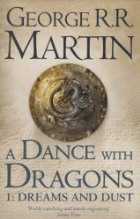 A Dance with Dragons: Dreams and Dust, George R.R. Martin A Dance with Dragons: Dreams and Dust, George R.R. Martin
I’ve been re-reading A Song of Ice and Fire for months mostly so I could get to book five finally (and so I could know what was going to happen on the show, as I’d forgotten a lot). Unfortunately, I remember A Feast for Crows as a disappointment, and I was pretty bummed that I didn’t much like this first installment of A Dance with Dragons, either. In the UK, they split it into these two books, and the first half just didn’t grab me although I slogged through. I guess I’d forgotten in my head how sexist, brutal, and depressing Martin’s world is. I was primarily disturbed by the excessive and unnecessary sexism, in this particular book; it just felt relentless and I didn’t enjoy the experience of reading the book as much as I thought I would. Plus, I think at this point, the series is just too long. A new minor character seems to pop up every other page, distracting me from the characters who are actually interesting to read about, but everything just gets worse for them too, with no actual break. It’s too dark, too long, too frustrating to read. I used to like this a whole lot more than I do now and discovering that has been disappointing. I haven’t been in a rush to pick up the second half and I’m not sure when I will.
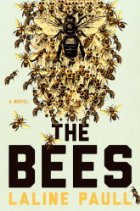 Flora 717 is a worker bee, designed to be a silent sanitation worker who simply picks up after her betters. But Flora can talk in a way that her sisters can’t, so despite the fact that she is an ugly, large brown bee, completely unlike her black-and-yellow striped siblings, she experiences life outside that of the other floras. She spends time feeding the baby bees and even goes foraging. But after a few days pass, and Flora meets the queen, she realizes she has a secret, and she can no longer follow the bees’ mantra: Accept. Obey. Serve. Instead, she has to think for herself and fight for what’s forbidden at all costs. Flora 717 is a worker bee, designed to be a silent sanitation worker who simply picks up after her betters. But Flora can talk in a way that her sisters can’t, so despite the fact that she is an ugly, large brown bee, completely unlike her black-and-yellow striped siblings, she experiences life outside that of the other floras. She spends time feeding the baby bees and even goes foraging. But after a few days pass, and Flora meets the queen, she realizes she has a secret, and she can no longer follow the bees’ mantra: Accept. Obey. Serve. Instead, she has to think for herself and fight for what’s forbidden at all costs.
This is an utterly unusual book. I picked it up as a review copy from Amazon Vine and, typically for me, didn’t actually read the description in any great detail. I just saw “The Hunger Games meets The Handmaid’s Tale” in the description and thought that this would be a book well worth my time, should that actually hold true. And, as it turned out, a book called The Bees is genuinely about bees. Funny, that – I mention it because it colored my experience of the book, especially at the beginning, and because it highlights that this is unusual. The back of the book itself actually also mentions Watership Down, which is probably a more apt comparison, at least as far as non-human subjects go. I can kind of see why they’ve compared it to those books, but it’s not really like them at all, and I can see how someone who was misdirected, who might be like me and not very fond of reading book descriptions, might not actually end up liking the book much.
Anyway, I digress. This was extremely engaging and extremely unusual. Laline Paull has taken the lifecycle of bees, something is generally taught in school and ignored afterwards, and turned it into a compelling story about differing from and defying the norm. Flora isn’t meant to be what she is. Other bees tell her that she’s too big, that she’s too ugly, that they dislike the privilege she appears to have been given, just due to the fact that she has talents outside her social class. They look down on her and every day she fights to be herself and to keep her own secrets from the world. She fights harder than the other bees because she’s different and because she feels she has to earn her privilege, which really made me root for her.
I’ll admit that I know next to nothing about bees, so I have genuinely no idea how “right” the author gets the way things actually work, but given that the bees tend to use dustpans and brushes and curtsey to each other, I don’t think she’s going for realism. It seems more to be a story about sticking to your own principles and doing what you feel is right, no matter who looks down on you or disdains you for it. But at the same time, by humanising these bees, she does highlight how little they fit in the modern world, and how little we understand or know about them.
The Bees‘s cover also says it’s “An extraordinary feat of imagination” and I think I’d agree with that. I certainly never thought about what it would be like in a beehive, but I appreciated the perspective and I liked the story. I’d recommend it if you’re looking for something different.
All external links are affiliate links. I received this book for free for review.
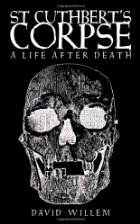 St. Cuthbert died over 1300 years ago, but the mystery of his incorrupt corpse has continued to fascinate generations of religious Brits, especially Northerners. Years after St Cuthbert died, a group of monks opened his tomb for the first time and were amazed to discover that he appeared lifelike in every way; though his body was covered with a white shroud, his limbs were flexible and his skin pliable. Over the centuries, his tomb has been moved across northeast England, finally finding a home in Durham Cathedral, but it’s been opened five times since with different discoveries made each time. David Willem looks at the original sources of each tomb opening to create the most reliable possible account of the corpse’s history. St. Cuthbert died over 1300 years ago, but the mystery of his incorrupt corpse has continued to fascinate generations of religious Brits, especially Northerners. Years after St Cuthbert died, a group of monks opened his tomb for the first time and were amazed to discover that he appeared lifelike in every way; though his body was covered with a white shroud, his limbs were flexible and his skin pliable. Over the centuries, his tomb has been moved across northeast England, finally finding a home in Durham Cathedral, but it’s been opened five times since with different discoveries made each time. David Willem looks at the original sources of each tomb opening to create the most reliable possible account of the corpse’s history.
I found this book unexpectedly fascinating, so much so that I actually came home from reading it on my commute and told my husband all about it (he’s not a history person but tends to listen patiently to my excited ramblings, as in this case). It’s a short book which I read over just two days, covering each instance of tomb-opening from the saint’s death to the last opening in 1899. There is no real ending possible, although the author does draw some conclusions; the saint’s corpse is still in the awe-inspiring Durham Cathedral, but it’s quite unlikely that it will be opened again any time soon. But the way he traces back the history and tries to figure out exactly what happened and how a corpse could be “incorrupt” two hundred years after burial was really interesting. It’s also fascinating to see what might happen to a prominent person’s body for centuries after death. This saint hasn’t been forgotten in the slightest and it does serve to remind us of how our mortal remains might gain a history of their own.
This is a very tightly focused book and doesn’t include much context; we don’t really learn much about what’s happening outside the small piece of the world inhabited by the corpse and those who tended to it. But for someone with a good background of the various periods of history, it’s clear that the corpse is actually impacted by each, from the Viking and Norman invasions to the dissolution of the monasteries right up to the later Victorian interest in antiquities. The way the corpse is treated is itself indicative of the general atmosphere at each given point. Very designed for people who already love history, rather than those who might be dipping their toe into the water, the book contains a number of excerpts from the primary sources consulted by the author. He’ll normally tell the story (and let it be told through the eyes of the primary sources) and then look more carefully at what the person has actually said.
In summary, I really enjoyed St. Cuthbert’s Corpse and would happily read more like it. A quick read that nevertheless adds a dimension onto history, certainly worth the time I spent reading it. I now know a lot more about St. Cuthbert and I’d like to go back to Durham Cathedral to visit the tomb in person.
I received this book for free for review.
 Promise of Blood is “flintlock fantasy” or, an epic fantasy set in a world with guns as well as magic, roughly equivalent to the 18th century (ish) in our world, a new-to-me genre. In this particular series, Field Marshal Tamas, the leader of the Powder Mages, who gain strength from gunpowder, has just overthrown Manhouch, the king, an exceptionally corrupt individual, and is now working to set up his own government against many who would prefer he not do just that. Some of those are in his inner circle, so Tamas enlists the help of Adamat, a private investigator, to find out exactly what’s going on, and his son Taniel “Two-shot” to protect his fledgling state from power-hungry neighbors. Promise of Blood is “flintlock fantasy” or, an epic fantasy set in a world with guns as well as magic, roughly equivalent to the 18th century (ish) in our world, a new-to-me genre. In this particular series, Field Marshal Tamas, the leader of the Powder Mages, who gain strength from gunpowder, has just overthrown Manhouch, the king, an exceptionally corrupt individual, and is now working to set up his own government against many who would prefer he not do just that. Some of those are in his inner circle, so Tamas enlists the help of Adamat, a private investigator, to find out exactly what’s going on, and his son Taniel “Two-shot” to protect his fledgling state from power-hungry neighbors.
The book felt to me very similar to those I’ve read about the French Revolution, except with a less redeemable monarchy and nobility. The fact that there are old-fashioned guns involved undoubtedly helped, as it seems to further the prospective era of the fantasy along in my head from the typical medieval-esque settings. The people are unhappy and the people are hungry; in the case, though, Tamas does genuinely want to help them. It made for a nice change and provided a different atmosphere than what I was used to. I’ve never read a book in this particular branch of fantasy before, as I generally start being less interested in history when guns get introduced, but I was pleasantly surprised.
I really liked the magic system. The Powder Mages don’t exist in isolation; there are also the Privileged, who work a different kind of magic entirely, and act in a sort of opposition to the Powder Mages. When first starting the book everything seemed very confusing, but it sorts itself out quickly and by the end of this first volume I felt very familiar with how everything was meant to work and who was who. I’d say it’s a similar learning curve to most books of this sort. If you’re starting a new epic fantasy series, you’re going to have to learn the ropes before you can enjoy the story, and this is one that drops its readers straight into the thick of it.
Undoubtedly this book benefited from the fact that I’ve spent the last few months craving fantasy (just like certain sets of historical fiction now suffer from over-reading). I really, really wanted to read a proper epic fantasy and this certainly started me off in that direction. It’s also fast-paced, with consequences that are wide and political but characters that are very human, aspects of books that I love. Probably its only fault is that virtually all of the characters and central players in it are men. Women are rarely featured in positions of power, with a few exceptions, in the particular society McClellan has created, although the foreign Ka-poel, Taniel’s bodyguard, is an excellent example of how women can subvert that. I think Ka-poel is the most interesting character in the book, simply because she’s mysterious and completely underrated by most of the other characters. I’m really looking forward to seeing where McClellan takes her.
Aside from that particular gripe, I really enjoyed this book. I loved the world and the magic system and I felt I really got to know the characters. I’m invested in what happens next and I’m looking forward to the second book in the series, The Crimson Campaign, out next month.
All external book links are affiliate links. I received this book for free for review.
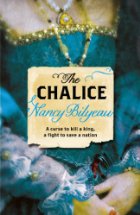 Joanna Stafford has been cast out of Dartford Priory with her fellow novices and nuns thanks to the dissolution of the monasteries, but she’s still attempting to live quietly with her five-year-old cousin, Arthur. Fate won’t let her, though; an unexpected visit with relations who have been restored to prominence embroils Joanna in a plot that threatens the very heart of the nation. Even as she attempts to move past her previous life with a man who loves her, she can’t escape the threads of prophecy that wind themselves tighter and tighter as England’s future grows murky. Joanna Stafford has been cast out of Dartford Priory with her fellow novices and nuns thanks to the dissolution of the monasteries, but she’s still attempting to live quietly with her five-year-old cousin, Arthur. Fate won’t let her, though; an unexpected visit with relations who have been restored to prominence embroils Joanna in a plot that threatens the very heart of the nation. Even as she attempts to move past her previous life with a man who loves her, she can’t escape the threads of prophecy that wind themselves tighter and tighter as England’s future grows murky.
When I started this book, I’d somehow missed that it was a second book in a series – my own fault for not reading summaries or synopsis of any kind! The author does a good job of filling us in on the missing history, but I would highly recommend reading The Crown first so you don’t miss anything even if by accident.
That aside, though, I really liked this book, to my surprise as generally Tudor fiction doesn’t do it for me any more. Joanna is great as a main character and has a perspective unlike any that I’d read before. She has two struggles in this book; the first is against the prophecy which attempts to dictate her life and the second is to actually find what that life should be after her life in the priory. She’s a very religious girl by nature and by education and her inclinations in that way color her interactions with other people.
I liked the way that the prophecy was interwoven into the story. One of the things that is difficult to grasp for a modern mindset is that, in the medieval period at least, “magic” was often stuck in with religion without people struggling to differentiate between the two. I think this is starting to change at this point in time, but the prophecies around Joanna don’t really conflict with her faith. The messages from the prophets are a gift, not a curse, although Joanna grapples with what they actually mean she must do. The implications of them are interesting albeit extremely unlikely from a historical perspective.
Probably the only thing that annoyed me about this particular book was the love interests. Joanna is clearly a novice in the ways of love as she is with the church, and she never expected to have romantic contact with men. The dissolution of the monasteries changed all that. Joanna is now not only beautiful, but she’s an eligible romantic interest, and two men have feelings for her; Geoffrey Scoville and Brother Edmund, a former monk. Because I had no real background without reading The Crown, I wasn’t able to see how these relationships developed, and I think that affected how I perceived them in this book. Plus, I felt like one in particular pretty much forced himself at her more than once when she wasn’t too thrilled about it, which meant I was not his biggest fan.
Still, though, I really enjoyed reading The Chalice and I can only imagine that I’d have liked it even more if I’d read The Crown, too. I definitely recommend that you start there, but it looks like Nancy Bilyeau is an author to watch.
All external book links are affiliate links. I received this book for free for review.
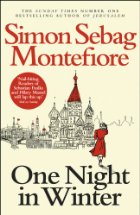 Andrei Kurbsky’s father was exiled to a labor camp and he and his mother have spent the last few years in Stalinabad. In 1945 Russia, everyone is under suspicion, and with Andrei’s chequered family history, it seems like a small miracle that he’s been accepted into Moscow’s top school – where Stalin’s own children were educated. Andrei finds himself rubbing shoulders with the children of film stars and top governmental officials, developing a crush on a girl called Serafima, who is one of the most sought-after teenagers in the school. He is swept into the Romantics Club, where several of the students re-enact scenes from Eugene Onegin, one of Pushkin’s most famous plays. But when two of the teens end up dead, Andrei, Serafima, and their friends, just children, land in Lubyanka prison, subject to the brutal interrogation methods that could end up destroying them and their entire families. Andrei Kurbsky’s father was exiled to a labor camp and he and his mother have spent the last few years in Stalinabad. In 1945 Russia, everyone is under suspicion, and with Andrei’s chequered family history, it seems like a small miracle that he’s been accepted into Moscow’s top school – where Stalin’s own children were educated. Andrei finds himself rubbing shoulders with the children of film stars and top governmental officials, developing a crush on a girl called Serafima, who is one of the most sought-after teenagers in the school. He is swept into the Romantics Club, where several of the students re-enact scenes from Eugene Onegin, one of Pushkin’s most famous plays. But when two of the teens end up dead, Andrei, Serafima, and their friends, just children, land in Lubyanka prison, subject to the brutal interrogation methods that could end up destroying them and their entire families.
If you’ve ever wondered what it might be like to have the state watch your every move, and arrest you on the slightest provocation, this book is one to read. It perfectly evokes the atmosphere of suspense and suspicion that haunted every single person in Moscow and in the rest of the Soviet Union. Any false move – even one that isn’t false – and prison awaited, along with the potential for exile to a labor camp where many suffered, including in this book Andrei’s father. For an idea of what this was like, I’d go read One Day in the Life of Ivan Denisovich by Aleksandr Solzhenitsyn – unforgettable. But this book covers instead the questioning, the wondering, and the suspense. No one was immune, not even these children.
Montefiore has written previous histories of Stalinist Russia, including biographies of the man himself, so he’s clearly done his research on the period which makes it easier to trust what he says. This is a surprisingly suspenseful novel; it’s easy to genuinely worry about Serafima, Andrei, and the other teens and children who find themselves in prison without being quite sure what they’ve done. The back story is revealed slowly, so we know Serafima has a secret from nearly the beginning of the book but aren’t sure what it is.
What I really liked in particular was the contrast between the children’s and some of their teacher’s love for what might be termed old Russian culture and the suspicious, derelict city of Moscow. Russia is still suffering the effects of the war and Stalin’s paranoia only increases as he ages; meanwhile in school, the teens admire the romance of Pushkin’s poetry and adore the teacher who shows them how life in the country used to be.
I really liked One Night in Winter; it’s a readable, tense, suspenseful account of what life may have been like during Stalin’s dictatorship. It has multiple threads of romance and mystery throughout, as well as a sincere homage to Russian culture. Recommended.
All external book links are affiliate links. I received this book for free for review.
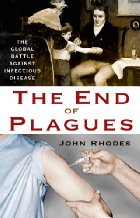 Disease is a constant in our lives. For those who aren’t privileged enough to live or be born in a first-world country, disease and death is an even greater, every day fear. But many of these diseases are now preventable, primarily due to vaccination, and it’s the history as well as the future of this very modern medical miracle that Rhodes explores with this book. As an example, smallpox used to kill two million people or more every year. Now, it’s virtually extinct, surviving in just two known test tubes in the world. Rhodes starts with the pioneering work of Edward Jenner and moves through time to explore the discovery and science of vaccination, its history, and the current fight against some of the world’s fiercest diseases. Disease is a constant in our lives. For those who aren’t privileged enough to live or be born in a first-world country, disease and death is an even greater, every day fear. But many of these diseases are now preventable, primarily due to vaccination, and it’s the history as well as the future of this very modern medical miracle that Rhodes explores with this book. As an example, smallpox used to kill two million people or more every year. Now, it’s virtually extinct, surviving in just two known test tubes in the world. Rhodes starts with the pioneering work of Edward Jenner and moves through time to explore the discovery and science of vaccination, its history, and the current fight against some of the world’s fiercest diseases.
The End of Plagues was a fascinating and unexpectedly inspiring book. I had never really learned (or don’t remember) anything about the history of vaccines in school or otherwise, but I’m always interested in learning more about the world. This book spans the entire world when it comes to the history of immunisation and the fight to eradicate diseases. Most of the discoveries were made in Europe and in the United States, but the latter part of the book focuses heavily on the struggles which have and still are taking place in the Middle East and Africa to finally defeat some of the illnesses with vaccines. Disease is truly global and Rhodes looks at the entire world to get a clearer picture of where progress lies; it’s easy to forget that diseases we’ve obliterated from our own countries still flourish in others with many still suffering from illnesses we no longer see. But the progress that we’ve collectively made is astounding and it’s inspiring to read about so many countries coming together and choosing to protect their people and improve the world in the fact of extraordinary difficulties.
The history was really interesting too, although the book skipped around a little bit in the initial chapters which made it harder to follow. I got the drift quickly though, as discoveries came in hard and fast after Jenner first made his vaccine. One thing I was surprised to learn is the chequered history of older vaccinations. Because the vaccines were actually developed before the corresponding science, there was a huge amount of trial and error and it’s immensely safer now that we actually understand exactly what happens when a vaccine is placed into someone’s body. It’s a balancing act and in many ways it’s fortuitous that Jenner made his discovery exactly how and when he did (the book refers to this as serendipity and it resulted in a couple of discoveries). Vaccines are safer now, but despite the element of luck those initial vaccines and the ongoing campaigns now have eliminated scourges that have haunted humans throughout history.
Rhodes is extremely fair when it comes to understanding why people refuse vaccines for their children and even shares his own experience with doubt. Although links between vaccination and autism have been disproven, there is still a vocal minority of people who are firmly against vaccination for various reasons. While their children definitely benefit from herd immunity, these people open cracks in our defense against serious illnesses. Rhodes explores the history of vaccination and where those worries come from. In the end, though it’s small consolation to the few parents whose children do suffer side effects, vaccination has changed the world much for the better. The simple fact that children can play outside in midsummer without worrying about permanent paralysis or death proves this. Rhodes isn’t heavy-handed, but logical and understanding; worries are there, but he went ahead and vaccinated his daughter because he knew the consequences that ensued from a lapse in that “herd immunity”.
Definitely recommended – whether you’re questioning vaccination, whether you’re interested in history, whether you’re curious about efforts to cure current scourges (primarily malaria and HIV), whether you just want to learn something new. This is a book I’m glad to have read.
All external links are affiliate links. I received this book for free for review.
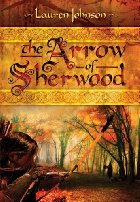 When Robin, Lord Locksley, arrives home from four years on Crusade, his family is astonished. His fiancée has become engaged to someone else, his mother has re-married a sheriff, and his estates have become entrusted to his young nephew, who has become the ward of the Viponts, one of the most dangerous families in Nottingham. They believed he was dead. Alive, he has to fight to regain what should be his by right. In doing so, he realizes that the Vipont family has been mistreating many of the lowborn families he grew up with; taxes are extremely high and the Viponts are closely allied to the Count of Mortmain, or John, King Richard I’s younger brother, who rules the country while his elder sibling is imprisoned in Germany. Justice is subverted and new laws are created to benefit the lords, not those who suffer under their leadership. Robin is convinced that something needs to be done, and as a lord without any of the benefits of lordship, perhaps he’s the one to do it. When Robin, Lord Locksley, arrives home from four years on Crusade, his family is astonished. His fiancée has become engaged to someone else, his mother has re-married a sheriff, and his estates have become entrusted to his young nephew, who has become the ward of the Viponts, one of the most dangerous families in Nottingham. They believed he was dead. Alive, he has to fight to regain what should be his by right. In doing so, he realizes that the Vipont family has been mistreating many of the lowborn families he grew up with; taxes are extremely high and the Viponts are closely allied to the Count of Mortmain, or John, King Richard I’s younger brother, who rules the country while his elder sibling is imprisoned in Germany. Justice is subverted and new laws are created to benefit the lords, not those who suffer under their leadership. Robin is convinced that something needs to be done, and as a lord without any of the benefits of lordship, perhaps he’s the one to do it.
The Arrow of Sherwood is written by a trained historian and it really shows in the best possible ways in this book. There are details which make it clear that this isn’t a tale of modern people in fancy old dresses or a gritty hack-and-slash which shows that the Middle Ages must have been brutal; instead, it’s somewhere in the middle, with scenes at court and scenes of battle and thievery. Johnson recaptures what sort of person Robin Hood might have actually been and the book’s realism, in my eyes, is a huge selling point and definitely set it apart. It’s also a bonus that this isn’t a book about the Tudors or the Plantagenets; it’s a realistic re-imagining of a legend and for that I couldn’t help but appreciate it hugely.
The book is well-written and takes us through Robin’s journey, which is fraught with twists and turns as he struggles with the almost insurmountable authority of the Vipont family. The book gives a really good idea of how much local families were stuck with each other; there are only so many people who have authority within a given region and if one person is higher up, that’s it for everyone else. Justice was a red hot iron pushed into your hand; if it was infected, you were guilty, and if it wasn’t, you were innocent.
The only issue I had with it was actually understanding the feasibility of the set-up behind Robin’s rescued prisoners. Towards the middle of the book we essentially have an entire “hundred” of people in a forest, masked as a leper colony, but one that no one ever finds except a couple of peasants and Marian and Elaine. In addition, Robin is juggling double identities and really doesn’t seem to lie very well. I had a difficult time believing he’d be able to keep the secrets with which he is entrusted and I didn’t understand why none of the Viponts ever think to follow Robin on his travels like some of the more minor characters do. The set-up seemed too convenient, although perhaps this is again just my modern brain not actually understanding the scale of a forest.
Definitely recommended for those who enjoy fiction set in the Middle Ages and, even though Robin Hood is a well-known legend, for something a bit different than the masses out there.
All external book links are affiliate links. I received this book for free for review.
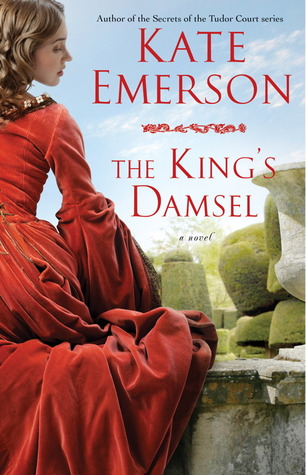 Young Tamsin Lodge, heiress, is sent from the arms of her loving stepmother into the tumultuous world of the Tudor court as a teenager. She quickly realizes that her best option to progress in life is not to mourn for what she’s lost, but to seize the opportunity to gain the influence of powerful people. Her guardian places her as a lady of honor to Princess Mary, who Tamsin grows to love, but as the dynamics of power at court shift, Tamsin has to choose her loyalties carefully and decide what’s best for herself, her family, and her kingdom. Young Tamsin Lodge, heiress, is sent from the arms of her loving stepmother into the tumultuous world of the Tudor court as a teenager. She quickly realizes that her best option to progress in life is not to mourn for what she’s lost, but to seize the opportunity to gain the influence of powerful people. Her guardian places her as a lady of honor to Princess Mary, who Tamsin grows to love, but as the dynamics of power at court shift, Tamsin has to choose her loyalties carefully and decide what’s best for herself, her family, and her kingdom.
The King’s Damsel is a book that should appeal immensely to fans of historical fiction. It’s a richly written, intriguing story of a fictional girl trying to make her way best through a very hostile Tudor court. She’s hampered by her own ignorance, due to her upbringing, but she’s earnest and she tries hard to make a difference. She encounters a huge number of genuine historical figures and indeed has some basis in historical fact. Unfortunately, it was not a book that I personally enjoyed very much, due to three reasons.
The first, which is most certainly not the book’s fault, is that I still haven’t recovered any sort of desire to read fiction about the Tudor court. I overdid this years ago and it seems the desire to actually read these books has not come back. There are a few works of historical fiction which have risen above this, but I didn’t find this to be one of them.
The second is the fact that the back cover gives away practically all of the story, which I’ve actually omitted from my own summary above. I really dislike when this happens; a crucial plot point in the last third of the book really shouldn’t be on the back cover. I’m guessing someone, somewhere thought the book wouldn’t be as appealing to potential readers without this detail, but I spent most of the first 2/3 of the book waiting for that to happen.
The third reason is that I didn’t really get on board with the romance, which seemed too cursory and unrealistic given the actual status of the people involved. I wasn’t really convinced by it, and it didn’t help much that the book skipped years with mostly not much happening. I understand that maybe much didn’t happen, but it didn’t help power the book along at all, and it was a little hard to imagine how a romance happened if the key figures only saw each other once a year. A year is a long time.
The book is only 300 or so pages long and took me 5 days to read, which for me kind of demonstrates how disinterested I was in it. A lot of that probably isn’t the book’s fault – looking elsewhere, it’s had pretty good reviews. It is likely that this book, and this series, might suit someone who is still keen on Tudor historical fiction. But that someone isn’t me.
I received this book for free for review.
|
|
 It’s 1460. Katherine is a young nun, caught outside her English priory by a group of rampaging knights during the Wars of the Roses. Her life is saved by a slightly older monk, Thomas, but her reputation isn’t. Not only has she spoken to a man, but her closest friend has died under suspicious circumstances, and Katherine finds herself expelled from the priory. Under related circumstances, so does Thomas, and these two young people find themselves with nothing and nowhere to go in the middle of a bloody civil war, fleeing from a knight whose mission is to kill them.
It’s 1460. Katherine is a young nun, caught outside her English priory by a group of rampaging knights during the Wars of the Roses. Her life is saved by a slightly older monk, Thomas, but her reputation isn’t. Not only has she spoken to a man, but her closest friend has died under suspicious circumstances, and Katherine finds herself expelled from the priory. Under related circumstances, so does Thomas, and these two young people find themselves with nothing and nowhere to go in the middle of a bloody civil war, fleeing from a knight whose mission is to kill them.

 I had a high and lofty goal of writing about everything I read this year, even if only a sentence, at the beginning of the year. I’ve failed at that, but here are a few thoughts on books I have read and think are worth talking about this year so far.
I had a high and lofty goal of writing about everything I read this year, even if only a sentence, at the beginning of the year. I’ve failed at that, but here are a few thoughts on books I have read and think are worth talking about this year so far. Germania, Simon Winder
Germania, Simon Winder A Dance with Dragons: Dreams and Dust, George R.R. Martin
A Dance with Dragons: Dreams and Dust, George R.R. Martin Flora 717 is a worker bee, designed to be a silent sanitation worker who simply picks up after her betters. But Flora can talk in a way that her sisters can’t, so despite the fact that she is an ugly, large brown bee, completely unlike her black-and-yellow striped siblings, she experiences life outside that of the other floras. She spends time feeding the baby bees and even goes foraging. But after a few days pass, and Flora meets the queen, she realizes she has a secret, and she can no longer follow the bees’ mantra: Accept. Obey. Serve. Instead, she has to think for herself and fight for what’s forbidden at all costs.
Flora 717 is a worker bee, designed to be a silent sanitation worker who simply picks up after her betters. But Flora can talk in a way that her sisters can’t, so despite the fact that she is an ugly, large brown bee, completely unlike her black-and-yellow striped siblings, she experiences life outside that of the other floras. She spends time feeding the baby bees and even goes foraging. But after a few days pass, and Flora meets the queen, she realizes she has a secret, and she can no longer follow the bees’ mantra: Accept. Obey. Serve. Instead, she has to think for herself and fight for what’s forbidden at all costs. St. Cuthbert died over 1300 years ago, but the mystery of his incorrupt corpse has continued to fascinate generations of religious Brits, especially Northerners. Years after St Cuthbert died, a group of monks opened his tomb for the first time and were amazed to discover that he appeared lifelike in every way; though his body was covered with a white shroud, his limbs were flexible and his skin pliable. Over the centuries, his tomb has been moved across northeast England, finally finding a home in Durham Cathedral, but it’s been opened five times since with different discoveries made each time. David Willem looks at the original sources of each tomb opening to create the most reliable possible account of the corpse’s history.
St. Cuthbert died over 1300 years ago, but the mystery of his incorrupt corpse has continued to fascinate generations of religious Brits, especially Northerners. Years after St Cuthbert died, a group of monks opened his tomb for the first time and were amazed to discover that he appeared lifelike in every way; though his body was covered with a white shroud, his limbs were flexible and his skin pliable. Over the centuries, his tomb has been moved across northeast England, finally finding a home in Durham Cathedral, but it’s been opened five times since with different discoveries made each time. David Willem looks at the original sources of each tomb opening to create the most reliable possible account of the corpse’s history. Promise of Blood is “flintlock fantasy” or, an epic fantasy set in a world with guns as well as magic, roughly equivalent to the 18th century (ish) in our world, a new-to-me genre. In this particular series, Field Marshal Tamas, the leader of the Powder Mages, who gain strength from gunpowder, has just overthrown Manhouch, the king, an exceptionally corrupt individual, and is now working to set up his own government against many who would prefer he not do just that. Some of those are in his inner circle, so Tamas enlists the help of Adamat, a private investigator, to find out exactly what’s going on, and his son Taniel “Two-shot” to protect his fledgling state from power-hungry neighbors.
Promise of Blood is “flintlock fantasy” or, an epic fantasy set in a world with guns as well as magic, roughly equivalent to the 18th century (ish) in our world, a new-to-me genre. In this particular series, Field Marshal Tamas, the leader of the Powder Mages, who gain strength from gunpowder, has just overthrown Manhouch, the king, an exceptionally corrupt individual, and is now working to set up his own government against many who would prefer he not do just that. Some of those are in his inner circle, so Tamas enlists the help of Adamat, a private investigator, to find out exactly what’s going on, and his son Taniel “Two-shot” to protect his fledgling state from power-hungry neighbors. Joanna Stafford has been cast out of Dartford Priory with her fellow novices and nuns thanks to the dissolution of the monasteries, but she’s still attempting to live quietly with her five-year-old cousin, Arthur. Fate won’t let her, though; an unexpected visit with relations who have been restored to prominence embroils Joanna in a plot that threatens the very heart of the nation. Even as she attempts to move past her previous life with a man who loves her, she can’t escape the threads of prophecy that wind themselves tighter and tighter as England’s future grows murky.
Joanna Stafford has been cast out of Dartford Priory with her fellow novices and nuns thanks to the dissolution of the monasteries, but she’s still attempting to live quietly with her five-year-old cousin, Arthur. Fate won’t let her, though; an unexpected visit with relations who have been restored to prominence embroils Joanna in a plot that threatens the very heart of the nation. Even as she attempts to move past her previous life with a man who loves her, she can’t escape the threads of prophecy that wind themselves tighter and tighter as England’s future grows murky. Andrei Kurbsky’s father was exiled to a labor camp and he and his mother have spent the last few years in Stalinabad. In 1945 Russia, everyone is under suspicion, and with Andrei’s chequered family history, it seems like a small miracle that he’s been accepted into Moscow’s top school – where Stalin’s own children were educated. Andrei finds himself rubbing shoulders with the children of film stars and top governmental officials, developing a crush on a girl called Serafima, who is one of the most sought-after teenagers in the school. He is swept into the Romantics Club, where several of the students re-enact scenes from Eugene Onegin, one of Pushkin’s most famous plays. But when two of the teens end up dead, Andrei, Serafima, and their friends, just children, land in Lubyanka prison, subject to the brutal interrogation methods that could end up destroying them and their entire families.
Andrei Kurbsky’s father was exiled to a labor camp and he and his mother have spent the last few years in Stalinabad. In 1945 Russia, everyone is under suspicion, and with Andrei’s chequered family history, it seems like a small miracle that he’s been accepted into Moscow’s top school – where Stalin’s own children were educated. Andrei finds himself rubbing shoulders with the children of film stars and top governmental officials, developing a crush on a girl called Serafima, who is one of the most sought-after teenagers in the school. He is swept into the Romantics Club, where several of the students re-enact scenes from Eugene Onegin, one of Pushkin’s most famous plays. But when two of the teens end up dead, Andrei, Serafima, and their friends, just children, land in Lubyanka prison, subject to the brutal interrogation methods that could end up destroying them and their entire families. Disease is a constant in our lives. For those who aren’t privileged enough to live or be born in a first-world country, disease and death is an even greater, every day fear. But many of these diseases are now preventable, primarily due to vaccination, and it’s the history as well as the future of this very modern medical miracle that Rhodes explores with this book. As an example, smallpox used to kill two million people or more every year. Now, it’s virtually extinct, surviving in just two known test tubes in the world. Rhodes starts with the pioneering work of Edward Jenner and moves through time to explore the discovery and science of vaccination, its history, and the current fight against some of the world’s fiercest diseases.
Disease is a constant in our lives. For those who aren’t privileged enough to live or be born in a first-world country, disease and death is an even greater, every day fear. But many of these diseases are now preventable, primarily due to vaccination, and it’s the history as well as the future of this very modern medical miracle that Rhodes explores with this book. As an example, smallpox used to kill two million people or more every year. Now, it’s virtually extinct, surviving in just two known test tubes in the world. Rhodes starts with the pioneering work of Edward Jenner and moves through time to explore the discovery and science of vaccination, its history, and the current fight against some of the world’s fiercest diseases. When Robin, Lord Locksley, arrives home from four years on Crusade, his family is astonished. His fiancée has become engaged to someone else, his mother has re-married a sheriff, and his estates have become entrusted to his young nephew, who has become the ward of the Viponts, one of the most dangerous families in Nottingham. They believed he was dead. Alive, he has to fight to regain what should be his by right. In doing so, he realizes that the Vipont family has been mistreating many of the lowborn families he grew up with; taxes are extremely high and the Viponts are closely allied to the Count of Mortmain, or John, King Richard I’s younger brother, who rules the country while his elder sibling is imprisoned in Germany. Justice is subverted and new laws are created to benefit the lords, not those who suffer under their leadership. Robin is convinced that something needs to be done, and as a lord without any of the benefits of lordship, perhaps he’s the one to do it.
When Robin, Lord Locksley, arrives home from four years on Crusade, his family is astonished. His fiancée has become engaged to someone else, his mother has re-married a sheriff, and his estates have become entrusted to his young nephew, who has become the ward of the Viponts, one of the most dangerous families in Nottingham. They believed he was dead. Alive, he has to fight to regain what should be his by right. In doing so, he realizes that the Vipont family has been mistreating many of the lowborn families he grew up with; taxes are extremely high and the Viponts are closely allied to the Count of Mortmain, or John, King Richard I’s younger brother, who rules the country while his elder sibling is imprisoned in Germany. Justice is subverted and new laws are created to benefit the lords, not those who suffer under their leadership. Robin is convinced that something needs to be done, and as a lord without any of the benefits of lordship, perhaps he’s the one to do it. Young Tamsin Lodge, heiress, is sent from the arms of her loving stepmother into the tumultuous world of the Tudor court as a teenager. She quickly realizes that her best option to progress in life is not to mourn for what she’s lost, but to seize the opportunity to gain the influence of powerful people. Her guardian places her as a lady of honor to Princess Mary, who Tamsin grows to love, but as the dynamics of power at court shift, Tamsin has to choose her loyalties carefully and decide what’s best for herself, her family, and her kingdom.
Young Tamsin Lodge, heiress, is sent from the arms of her loving stepmother into the tumultuous world of the Tudor court as a teenager. She quickly realizes that her best option to progress in life is not to mourn for what she’s lost, but to seize the opportunity to gain the influence of powerful people. Her guardian places her as a lady of honor to Princess Mary, who Tamsin grows to love, but as the dynamics of power at court shift, Tamsin has to choose her loyalties carefully and decide what’s best for herself, her family, and her kingdom.






Recent Comments